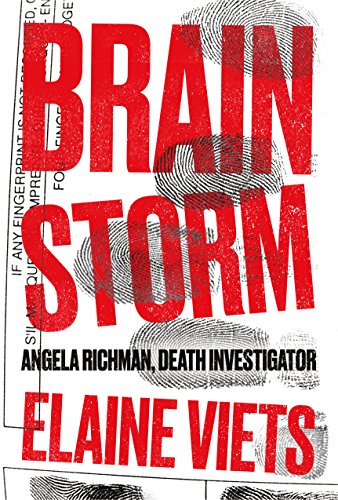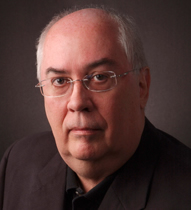Brain Storm by Elaine Viets
 By Joe Moore
By Joe Moore
Changing course in the middle of a successful writing career is a big gamble. Especially moving from light, humorous novels to much darker, serious subject matter. When I heard that my friend Elaine Viets was doing just that with her new novel, BRAIN STORM, I had to find out why. It came as no surprise that her motivation grew from events in her life. Now I know that this course change will be just as successful as her previous path. Here’s what I learned.
Elaine, why write a dark psychological suspense novel? You’re best known for your funny Dead-End Job mysteries and cozy Mystery Shopper novels?
I started writing dark novels, the Francesca Vierling newspaper mysteries for Bantam Dell. Then the publisher’s division was wiped out, and I spent two years working dead-end jobs in Florida, where the work is weird and the customers are weirder. I met witches buying a book of spells in a Barnes & Noble, very old men buying skimpy outfits for very young women, and bridezillas who wanted their bridesmaids’ dresses to match the hotel carpet. They inspired the funny, traditional mysteries in the Dead-End Job series for Penguin. That series did well, and Penguin asked me to write the cozy Josie Marcus, Mystery Shopper series. The series got off to a good start when Dying in Style tied for first place with Stephen King on the Independent Mystery Booksellers Association bestseller list. Meanwhile, I kept writing dark short stories for anthologies edited by Lawrence Block, Charlaine Harris and others. Josie was supposed to be a three-book series, but by book ten I felt I’d done all I could with that series. My agent rolled the last Josie book into the 15th Dead-End Job mystery.
But I’d gone through some very dark times, and my writing was turning dark. I wanted to explore the one fear that we cannot escape: our own mortality. Brain Storm is a deeply personal mystery, with hardheaded forensics.
What research did you do for BRAIN STORM?
I took the Medicolegal Death Investigators Training Course for forensic professionals given by St. Louis University’s School of Medicine. Here are the topics for just one day of the two-credit college course: We started with gunshot fatalities, explosion-related deaths, motor vehicle fatalities and drowning–before lunch. During lunch we watched a teen driving and alcohol video, which made me want to buy an armored personnel carrier. After lunch it was alcohol-related deaths, suicide, blunt trauma fatalities and more. So much more I was a vegetarian for about six weeks.
Is BRAIN STORM based on your personal experience?
Yes. Eight years ago, I went to the ER with severe headaches and other stroke symptoms. The neurologist on call said I was “too young and fit to have a stroke,” and sent me home. I was supposed to return for a PET scan in a few days. That day never happened. I had six strokes, including a hemorrhagic stroke, and needed emergency brain surgery. The ER doctor told my husband I’d be dead by morning. I was saved by a smart, skillful brain surgeon and spent a week in a coma, and three months in the hospital. It took nearly four years, but I’m almost completely recovered. I enjoyed killing the doctor who misdiagnosed me in BRAIN STORM. I just wish his death could have been more painful.
Will this be a series?
Yes. I’m working on Fire and Ashes, the second Angela Richman, Death Investigator mystery.
What is a death investigator?
DIs are professionals who perform independent, scientific investigations of unattended deaths. The DI takes charge of the body at the scene. She conducts a painstaking examination called “body actualization” that includes noting every cut, bruise and injury. The DI catalogues the body’s clothing and jewelry, takes the body temperature, the ambient (air) temperature and more. The body belongs to the DI until it goes to the medical examiner. The police process the crime scene. Death investigators work with the medical examiner. The profession was created in 1978 in response to a critical shortage of forensic pathologists. Death investigators are sort of like forensic paralegals. Angela Richman is the only known death investigator series in the mystery genre, according to Janet Rudolph, founder of Mystery Readers International and Mystery Readers Journal. Janet searched her files for other examples and said, “Your series is unique.”
How will your current fan base react to this turn in your writing?
I surveyed my readers about my new death investigator series and 1,046 answered. More than 75% said they would read the DI series. Almost half would prefer the death investigator series. Out of the 524 comments, 299 readers said they would read both my light and dark mysteries. One reader said, “I have loved your current series, I would love to see you tackle something a little darker. As a male, the new series appeals to me.”
Another said, “Like to see some real menace in your books.”
*****
 Award-winning mystery writer Elaine Viets has written 29 mysteries in three series. The Art of Murder is her fifteenth Dead-End Job mystery. Brain Storm, the first book in her Angela Richman, Death Investigator series, debuts August 2 as a trade paperback, e-book and MP3 CD.
Award-winning mystery writer Elaine Viets has written 29 mysteries in three series. The Art of Murder is her fifteenth Dead-End Job mystery. Brain Storm, the first book in her Angela Richman, Death Investigator series, debuts August 2 as a trade paperback, e-book and MP3 CD.
To learn more about Elaine, please visit her website.
*****
 Joe Moore is a former marketing & communications executive and two-time EMMY® winner with 25 years’ experience in the television postproduction industry. He has written articles for national and international trade magazines covering the field of professional sound recording and video. As a freelance writer, he reviewed fiction for the South Florida Sun-Sentinel, the Florida Times Union, and the Tampa Tribune.
Joe Moore is a former marketing & communications executive and two-time EMMY® winner with 25 years’ experience in the television postproduction industry. He has written articles for national and international trade magazines covering the field of professional sound recording and video. As a freelance writer, he reviewed fiction for the South Florida Sun-Sentinel, the Florida Times Union, and the Tampa Tribune.
Joe is president emeritus of the International Thriller Writers. He writes full time from his home on the banks of the Blackwater River near Pensacola, FL.
- THE GOD IN THE SEA with Paul Kemprecos - April 4, 2024
- FOR WORSE with L. K. Bowen - April 4, 2024
- HIT AND RUN with Vincent Zandri - April 4, 2024
